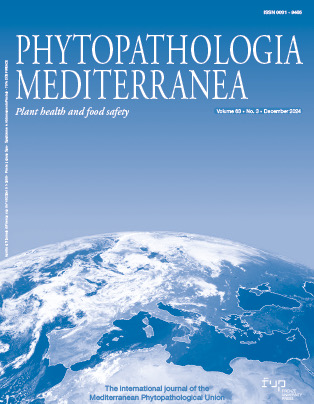Molecular and morphological characterisation of a new record of Bursaphelenchus arthuri (Nematoda: Aphelenchoididae) from a new host, Pinus pinea, in Europe
Published 2024-12-30
Keywords
- Centennial tree,
- D2-D3 expansion region sequencing,
- morphobiometrics,
- nematode,
- PCR-ITS-RFLP
How to Cite
Copyright (c) 2024 Hugo SILVA, Joana M.S. CARDOSO, Ricardo M.F. DA COSTA, Isabel ABRANTES, Luís FONSECA

This work is licensed under a Creative Commons Attribution 4.0 International License.
Abstract
Nematodes with morphological characters of Bursaphelenchus arthuri, a species of the Fungivorus group, first described in 2005 in China from imported coniferous packaging wood, were extracted from a centennial Pinus pinea tree with wilting symptoms in Coimbra, Portugal. Nematodes were transferred to Botrytis cinerea cultures to establish a nematode isolate which was characterised using morphological, morphometrical and molecular methods. Restriction fragment length polymorphism (RFLP) analysis carried out with five endonucleases of amplified internal transcribed spacer (ITS) of the rDNA region, revealed the characteristic restriction pattern described for Bursaphelenchus arthuri. Sequencing of the D2-D3 expansion region of the large subunit (LSU) of rDNA confirmed this identification. Phylogenetic analysis based on multiple sequence alignment of selected D2-D3 sequences showed that the Portuguese B. arthuri isolate formed a separate group, along with the other B. arthuri isolate from Taiwan available in GenBank, from those of other isolates of closely related nematodes species belonging to the Fungivorus group. This study is the first report of B. arthuri in Europe and from P. pinea.
Downloads
References
- Amin B., 2007. Host and temperature preference, male occurrence and morphometrics of fungivorous nematode, Aphelenchus avenae isolates from Japan. Jurnal Agripet 7: 39–47. https://jurnal.usk.ac.id/agripet/article/view/3312 DOI: https://doi.org/10.17969/agripet.v7i1.3312
- Altschul S.F., Madden T.L., Schaffer A.A., Zhang J.H., Zhang Z., Miller W., Lipman, D.J., 1997. Gapped BLAST and PSI-BLAST: a new generation of protein database search programs. Nucleic Acids Research 25: 3389–3402. https://www.ncbi.nlm.nih.gov/pmc/articles/PMC146917/ DOI: https://doi.org/10.1093/nar/25.17.3389
- Burgermeister W., Gu J., Braasch H., 2005. Bursaphelenchus arthuri sp. n. (Nematoda: Parasitaphelenchidae) in packaging wood from Taiwan and South Korea-a new species belonging to the fungivorus group. Journal of Nematode Morphology and Systematics 8: 7–17. https://revistaselectronicas.ujaen.es/index.php/jnms/article/view/85
- Burgermeister W., Braasch H., Metge K., Gu J., Schröder T., Woldt E., 2009. ITS-RFLP analysis, an efficient tool for differentiation of Bursaphelenchus species. Nematology 11: 649–668. https://brill.com/view/journals/nemy/11/5/article-p649_2.xml DOI: https://doi.org/10.1163/156854108/399182
- EPPO, 2013. PM 7/119 (1) Nematode extraction. EPPO Bulletin 43: 471–495. https://doi.org/10.1111/epp.12077 DOI: https://doi.org/10.1111/epp.12077
- EPPO, 2023. PM 7/4 (4) Bursaphelenchus xylophilus EPPO Bulletin 53: 156–183. https://doi.org/10.1111/epp.12915 DOI: https://doi.org/10.1111/epp.12915
- EPPO, 2024. Bursaphelenchus xylophilus. EPPO datasheets on pests recommended for regulation. https://gd.eppo.int (accessed 2024-09-02).
- Fonseca L., Santos M.C.V., Santos M.S., Curtis R.H.C., Abrantes I.M.O., 2008. Morpho-biometrical characterisation of Portuguese Bursaphelenchus xylophilus isolates with mucronate, digitate or round tailed females. Phytopathologia Mediterranea 47: 223–233. https://oajournals.fupress.net/index.php/pm/article/view/5252
- Ferris V.R., Ferris J.M., Faghihi J., 1993. Variation in spacer ribosomal DNA in some cyst-forming species of plant parasitic nematodes. Fundamental Applied Nematology 16: 177–184. https://horizon.documentation.ird.fr/exl-doc/pleins_textes/fan/40289.pdf
- Grzelak K., Gluchowska M., Kędra M., Błażewicz M., 2020. Nematode responses to an Arctic sea-ice regime: morphometric characteristics and biomass size spectra. Marine Environmental Research 162: 105181. https://www.sciencedirect.com/science/article/pii/S0141113620305456 DOI: https://doi.org/10.1016/j.marenvres.2020.105181
- Gu J., Braasch H., Burgermeister W., Zhang J., 2006. Records of Bursaphelenchus spp. intercepted in imported packaging wood at Ningbo, China. Forest Pathology 36: 323–333. https://onlinelibrary.wiley.com/doi/abs/10.1111/j.1439-0329.2006.00462.x DOI: https://doi.org/10.1111/j.1439-0329.2006.00462.x
- Gu J., Zhang J., Chen X., Braasch H., Burgermeister W., 2008. Bursaphelenchus spp. in wood packaging intercepted in China. In: Pine Wilt Disease: A Worldwide Threat to Forest Ecosystems (M. Mota, P. Vieira, ed), Springer. pp. 83–88. https://link.springer.com/book/10.1007/978-1-4020-8455-3 DOI: https://doi.org/10.1007/978-1-4020-8455-3_7
- Gu J., Wang J., Zheng J., 2012. Description of Bursaphelenchus arthuroides sp. n. (Nematoda: Aphelenchoididae), a second parthenogenetic species of Bursaphelenchus Fuchs, 1937. Nematology 14: 51–63. https://brill.com/view/journals/nemy/14/1/article-p51_5.xml DOI: https://doi.org/10.1163/138855411X578365
- Hall T.A., 1999. BioEdit: a user-friendly biological sequence alignment editor and analysis program for Windows 95/98/NT. Nucleic Acids Symposium Series 41: 95–98. https://www.academia.edu/2034992/
- Kanzaki N., Tanaka R., Giblin-Davis R.M., Davies K.A., 2014. New plant-parasitic nematode from the mostly mycophagous genus Bursaphelenchus discovered inside figs in Japan. PLoS One 9: e99241. https://pubmed.ncbi.nlm.nih.gov/35385500/ DOI: https://doi.org/10.1371/journal.pone.0099241
- Kanzaki N., Aikawa T., Maehara N., Thu P.Q., 2016. Bursaphelenchus kesiyae n. sp. (Nematoda: Aphelenchoididae), isolated from dead wood of Pinus kesiya Royle ex Gordon (Pinaceae) from Vietnam, with proposal of new subgroups in the B. fungivorus group. Nematology 18: 133–146. https://brill.com/view/journals/nemy/18/2/article-p133_2.xml DOI: https://doi.org/10.1163/15685411-00002949
- Kanzaki N., Kruger M.S., Greeff J.M., Giblin-Davis M., 2022. Bursaphelenchus suri n. sp.: A second Bursaphelenchus syconial parasite of figs supports adaptive radiation among section Sycomorus figs. PLoS One 17: e0265339. https://journals.plos.org/plosone/article?id=10.1371/journal.pone.0099241 DOI: https://doi.org/10.1371/journal.pone.0265339
- Ley P.D., Felix M., Frisse L., Nadler S., Sternberg P., Thomas, W.K., 1999. Molecular and morphological characterisation of two reproductively isolated species with mirror-image anatomy (Nematoda: Cephalobidae). Nematology 1: 591–612. https://brill.com/view/journals/nemy/1/6/article-p591_2.xml DOI: https://doi.org/10.1163/156854199508559
- Nguyen M.Y., Vanreusel A., Lins L., Thanh T.T., Bezerra T.N., Nghia S.H., Xuan Q.N., 2023. Nematode’s morphometric shifts related to changing environmental conditions in the Mekong estuaries Ba Lai and Ham Luong, Vietnam. Environmental Science and Pollution Research 30: 70974–70984. https://pubmed.ncbi.nlm.nih.gov/37160517/ DOI: https://doi.org/10.1007/s11356-023-27399-y
- Saitou N., Nei M., 1987. The Neighbor-Joining method – a new method for reconstructing phylogenetic trees. Molecular Biology and Evolution 4: 406–425. https://academic.oup.com/mbe/article/4/4/406/1029664
- Silva H., Cardoso J.M.S., da Costa R.M.F., Abrantes I., Fonseca L., 2023. Potensaphelenchus stammeri (Körner, 1954) Gu, Liu, Abolafia & Pedram, 2021 (Nematoda: Aphelenchoididae) from Pinus pinea Linnaeus, 1753 in Portugal. Forests 14: 962. https://www.mdpi.com/1999-4907/14/5/962 DOI: https://doi.org/10.3390/f14050962
- Tamura K., Stecher G., Kumar S., .2021. MEGA 11: Molecular Evolutionary Genetics Analysis Version 11. Molecular Biology and Evolution 38: 3022–3027. https://academic.oup.com/mbe/article/38/7/3022/6248099 DOI: https://doi.org/10.1093/molbev/msab120
- Vrain T.C., 1993. Restriction Fragment Length Polymorphism separates species of the Xiphinema americanum group. Journal of Nematology 25: 361–364. https://www.ncbi.nlm.nih.gov/pmc/articles/PMC2619403/pdf/361.pdf
- Wang X., Fang Y., Maria M., Gu J., Ge J., 2019. Description of Bursaphelenchus rockyi n. sp. (Nematoda: Aphelenchoididae) in peat moss from Russia. Nematology 21: 253–265. https://brill.com/view/journals/nemy/21/3/article-p253_3.xml DOI: https://doi.org/10.1163/15685411-00003211
- Whitehead A.G., Hemming J.R., 1965. A comparison of some quantitative methods of extracting small vermiform nematodes from soil. Annals of Applied Biology 55: 25–38. https://onlinelibrary.wiley.com/doi/abs/10.1111/j.1744-7348.1965.tb07864.x DOI: https://doi.org/10.1111/j.1744-7348.1965.tb07864.x






